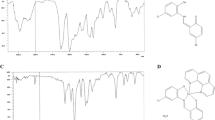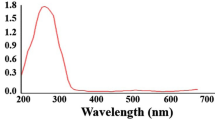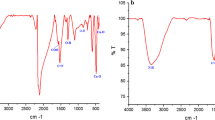Abstract
Copper is known for its bactericidal properties since ancient time. Development of copper nanoparticle (CNP) based antimicrobial products has generated interest in studying their toxicological properties. In this article, we have investigated the ROS (reactive oxygen species)–induced cytotoxicity of colloidal CNPs on MCF-7 human breast cancer cells. To understand the dependence of nanoparticle’s anticancer potential on their per batch yield, three identical sets of CNPs with similar physical properties with hydrodynamic size (11–14 nm) were prepared by chemical reduction method with per batch yield of 0.2 g, 0.3 g, and 0.4 g. Dose-dependent toxicity of as-synthesized (i.e., without any post preparation treatment) CNPs was evaluated by MTT (3-(4,5-dimethylthiazol-2-yl)-2,5-diphenyltetrazolium bromide) colorimetric assay for CNP concentrations of 0.001–100 μg/mL. Strong dose-dependent toxicity was observed in all CNPs batches, which was because of the mitochondrial damage in MCF-7. Cytotoxicity in MCF-7 exposed to CNPs was observed due to rupture of cell membrane and shrinkage as well as oxidative stress induced by reactive oxygen species (ROS). IC50 values of CNPs were independent of per batch yield of CNPs. This confirms that increase in CNPs yield from 0.2 to 0.4 g has no negative correlation with their cytotoxic response. The ability to scale up the nanoparticle yield with strong dose-dependent cytotoxicity makes CNPs potential candidate for the development of anticancer drugs.

Graphical Abstract
An electrochemical mixed aptamer-antibody sandwich assay based on the aptamer-induced HCR amplification strategy was fabricated for the highly sensitive detection of MUC16. The mixed aptamer-antibody sandwich assay showed acceptable performance of detection range, detection limit, reproducibility, and selectivity.






Similar content being viewed by others
References
Ahmad J, Alhadlaq HA, Alshamsan AWS, Siddiqui MA, Saquib Q, Khan ST, Wahab R, Al-Khedhairy AA, Musarrat J, Akhar MJ, Ahamed M (2016) Differential cytotoxicity of copper ferrite nanoparticles in different human cells. J App. Toxicol 36:1284–1293
Alhadlaq HA, Akhtar MJ, Ahamed M (2015) Zinc ferrite nanoparticles- induced cytotoxicity and oxidative stress in different human cells. Cell Biosc 5:1–11
Avalos A, Haza AI, Mateo D, Morales P (2014) Cytotoxicity and ROS production of manufactured silver nanoparticles of different size in heptoma and leukemia cells. J Appl Toxicol 34:413–423
Azizi M, Hedayatollah G, Fatemeh Y, Fariba D, Hojjat A (2017) Cytotoxic effect of albumin coated copper nanoparticles on human breast cancer cells of MDA-MB 231. PLoS One 12:e0188639
Berridge MV, Tan AS (1993) Characterization of the cellular reduction of 3-(4,5-dimethylthiazol-2-yl)-2,5-diphenyltetrazolium bromide (MTT): subcellular localization, substrate dependence, and involvement of mitochondrial electron transport in MTT reduction. Ach Biochem Biophys 303:474–482
Cai R, Zhang B, Shi J, Li M, He Z (2017) Rapid photocatalytic decolorization of methyl orange under visible light using VS4/carbon powder nanocomposites. ACS Sustain Chem Eng 5:7690–7699
Chakraborty R, Basu T (2017) Metallic copper nanoparticles induce apoptosis in Human skin melanoma A-375 cell line. Nanotechnology 28:105101
Chandra S, Das P, Bag S, Laha D, Parmanik P (2011) Synthesis, functionalization and bioimaging applications of highly fluorescent carbon nanoparticles. Nanoscale 3:1533–1540
Chen Z, Meng H, Xing G, Chen C, Zhao Y, Jia G, Wang T, Yuan H, Ye C, Zhao F, Chai Z, Zhu C, Fang X, Ma B, Wan L (2006) Acute toxicological effects of copper nanoparticles in vivo. Toxicol Lett 163:109–120
Clarance P, Lenakar B, Sales J, Kherson A, Agarstian P, Tack JC, Alkhulaifi MM, Al- shwaiman HA, Elgorban AM, Syed A, Kim HJ (2020) Green synthesis and characterization of gold nanoparticles using endophytic fungi Fusarium solani and its in-vitro anticancer and biomedical applications. Saudi J Biol Sci 27:706–712
Firdhouse JM, Lalitha P (2015) Apoptotic efficacy of biogenic silver nanoparticles on human breast cancer MCF-7 cell lines. Prog Biomater 4:113–121
Gaharwar US, Meena R, Rajamani P (2017) Iron oxide nanoparticles induced cytotoxicity, oxidative stress and DNA damage in lymphocytes. J Appl Toxicol 37:1232–1244
Guajardo-Pacheco MJ, Morales-sanchaz JE, Hernanadez JG, Ruiz F (2010) Synthesis of copper nanoparticles using soybean as a chelant agent. Mater Lett 64:1361–1364
Hong W, Joseph JA (1999) Quantifying cellular oxidative stress by dichlorofluorscein assay using microplate reader. Free Radic Biol Med 27:612–616
Hu R, Yong KT, Roy I, Ding H, He S, Prasad PN (2009) Metallic nanostructures as localized plasmon resonance enhanced scattering probes for multiplex dark-field targeted imaging of cancer cells. J Phys Chem C 113:2676–2684
Janic B, Liu F, Bobbitt KR, Brown SL, Chetty IJ, Mao G, Movsas B, Wen N (2018) Cellular uptake and radio-sensitization effect of small gold nanoparticles in MCF-7 breast cancer cells. J Nanomed Nanotechnol 9:1–13
Jeong YS, Oh WK, Kim S, Jang J (2011) Cellular uptake, cytotoxicity, and ROS generation with silica/conducting polymer core/shell nanospheres. Biomaterials 32:7217–7225
Kawaski ES, Player A (2005) Nanotechnology, nanomedicine and the development of new, effective therapies for cancer. Nanomedicine 1:101–109
Khan FA, Akhtar S, Almofty SA, Almohazed D, Alomeri M (2018) FMSP-nanoparticles induced cell death on human breast adenocarcinoma cell line (MCF-7 Cells): morphometric analysis. Biomolecules 8:1–13
Kheirollahi A, Pordeli M, Safavi M, Mashkouri S, Naimi-Jamal MR, Ardestani SK (2014) Cytotoxic and apoptotic effects of synthetic benzochromene derivatives on human cancer cell lines. Naunyn Schmiedeberg's Arch Pharmacol 387:1199–1208
Khurana C, Vala AK, Andhariya N, Pandey OP, Chudasama B (2014) Antibacterial activity of silver: the role of hydrodynamic particle size at Nanoscale. J Biomed Mater Res part A 102:3361–3368
Khurana C, Sharma P, Pandey OP, Chudasama B (2016) Synergistic effect of metal nanoparticles on the antimicrobial activities of antibiotics against biorecycling microbes. J Mater Sci Technol 32:524–532
Kumari R, Saini AK, Kumar A, Saini VR (2020) Apoptosis induction in lung and prostate cancer cells through silver nanoparticles synthesized from Pinus roxburghii bioactive fraction. JBIC 25:23–37
Kwan YP, Saito T, Ibrahim D, Saleh Al-Hassan FM, Oon CE, Chen Y, Jothy SL, Kanwar JR, Sasidharan S (2016) Evaluation of the cytotoxicity, cell-cycle arrest, and apoptotic induction by Euphorbia hirta in MCF-7 breast cancer cells. Pharm Biol 54:1223–1236
Lanone S, Francoise R, Jorina G, Aurelie D, Emmanuelle MM, Jorge B, Ghislaine L, Peter H (2009) Comparative toxicity of 24 manufactured nanoparticles in human alveolar epithelial and macrophage cell lines. Part Fiber Toxicol 6:1–12
Li L, Sun J, Li X, Zhang Y, Wang Z, Wang C, Dai J, Wang Q (2012) Controllable synthesis of monodispersed silver nanoparticles as standards for quantitative assessment of their cytotoxicity. Biomaterials 33:1714–1721
Maqusood A, Akhtar JV, Hisham AA, Aws A (2016) Copper ferrite nanoparticles- induced cytotoxicity and oxidative stress in human breast cancer MCF-7 cells. Colloids Surf B: Biointerfaces 142:46–54
Nel A, Xia T, MaEdler L, Li N (2006) Toxic potential of materials at the nanolevel. Science 31:622–627
Prabhu BM, Ali SF, Murdock RC, Hussain SM, Srivatsan M (2010) Copper nanoparticles exert size and concentration dependent toxicity on somatosensory neurons of rat. Nanotoxicology 4:150–160
Qing L, Zhang B, Xing X, Zhao Y, Cai R, Wang W, Gu Q (2018) Biosynthesis of copper nanoparticles using Shewanella coihica PV-4 with antibacterial activity: novel approach and mechanisms investigations. J Hazard Mater 347:141–149
Rizvi SAA, Saleh AM (2018) Applications of nanoparticles system in drug delivery technology. SPJ 26:64–70
Saranya R, Zali MM (2017) Synthesis of colloidal copper nanoparticles and its cytotoxicity effects on MCF-7 breast cancer cell lines. JCHPS 1:1–5
Song L, Mona C, Maria FL, Martina GV, Marta F, Estefania C, Greet RS, Wellie JGM, Jose MN (2014) Species-specific toxicity of copper nanoparticles among mammalian and piscine cell lines. Nanotoxicology 8(4):383–393
Sumit JK, Ranjana P, Sandeep PK, Tejo NP (2018) Bioaceesible selenium sourced from Se-rich mustard cake facilities protection from TBHP induced cytotoxicity in melanoma cells. Food Funct 9:1998–2004
Tang H, Xu M, Zhou XR, Zhang X, Zhao L, Ye G, Shi F, Lv C, LI Y (2018) Acute toxicity and biodistribution of different sized copper nano-particles in rats after oral administration. Mater Sci Eng C Mater Biol Appl 93:649–663
Vivek S, Neha L, Vikas H, Manoj B (2017) Amomum subulatum seed extract exhibit antioxidant, cytotoxic and immune-suppressive effect. IJBB 54:135–139
Wang W, Zhanga B, Liua Q, Dub P, Liub W, Hec Z (2018) Biosynthesis of palladium nanoparticles using Shewanella loihica PV-4 for excellent catalytic reduction of chromium (VI). Environ Sci Nano 5:730–739
Yanjie Y, Jing N, Jianwen H, Bianfei Y, Tong Z, Shung X, Shauangyu L, Haixia Z (2014) Cytotoxicity of gold nanoclusters in human liver cancer cells. In J Nanomedicine 9:5441–5448
Zhang Z, Wang H, Maocani Y, Wang H, Zhang C (2017) Novel copper complexes as potential proteasome inhibitors for cancer treatment. Mol Med Rep 15:3–11
Zhang B, Zou S, Cai R, Li M, He Z (2018) Highly-efficient photocatalytic disinfection of Escherichia coli under visible light under carbon supported vanadium tetrasulfide nanocomposites. Appl catal B 224:383–393
Acknowledgments
The authors are thankful to DST, New Delhi, for the FIST - I (SR/FST/PSI-176/2012) program.
Author information
Authors and Affiliations
Contributions
All the authors have contributed equally in this manuscript.
Corresponding author
Ethics declarations
Conflict of interest
The authors declare that they have no conflict of interest.
Additional information
Xiaoshan (Sean) Zhu, University of Nevada, Guest Editor
Publisher’s note
Springer Nature remains neutral with regard to jurisdictional claims in published maps and institutional affiliations.
This article is part of the topical collection: Nanoparticles in Biotechnology and Medicine
Electronic supplementary material
ESM 1
(DOCX 14 kb)
Rights and permissions
About this article
Cite this article
Sharma, P., Goyal, D., Baranwal, M. et al. ROS-induced cytotoxicity of colloidal copper nanoparticles in MCF-7 human breast cancer cell line: an in vitro study. J Nanopart Res 22, 244 (2020). https://doi.org/10.1007/s11051-020-04976-7
Received:
Accepted:
Published:
DOI: https://doi.org/10.1007/s11051-020-04976-7




